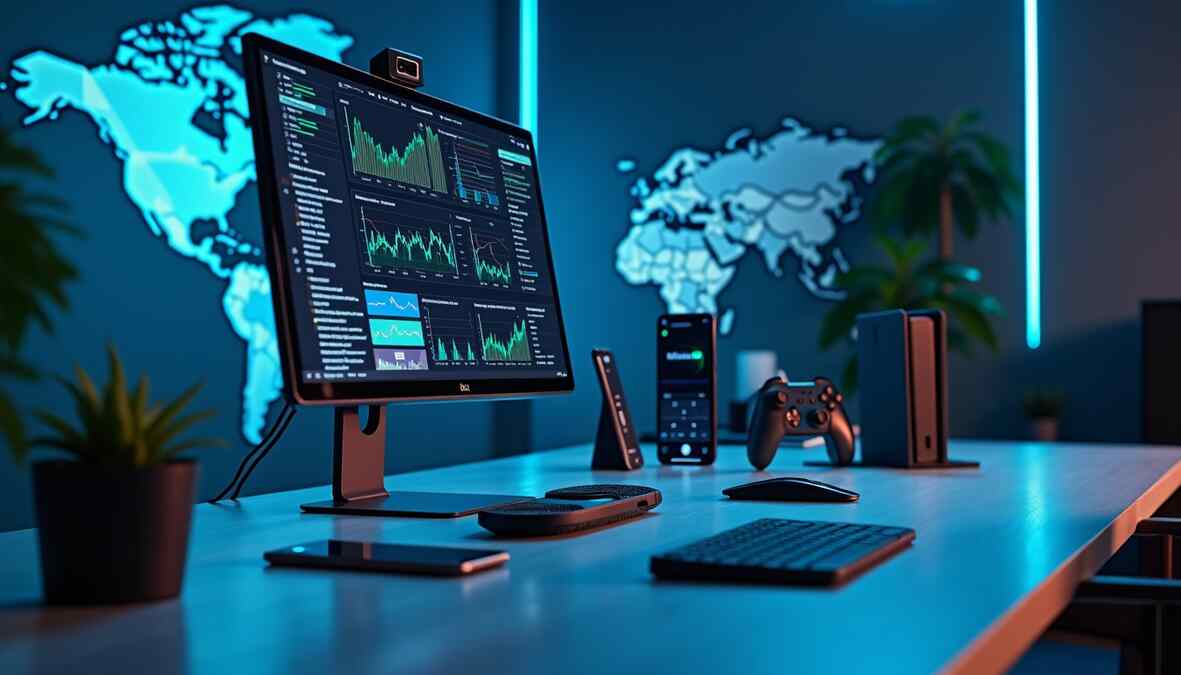Tech News: Groundbreaking developments and major legal battles dominate the 2025 tech news landscape. Google now faces potential risks after “willfully engage in anticompetitive acts” in a landmark ad tech monopoly case. TSMC’s plans include a massive $100 billion investment toward US chipmaking operations.
The digital world keeps changing faster. OpenAI’s new o3 model demonstrates better accuracy but raises hallucination risks. Nintendo will launch its Switch 2 with a $449.99 price tag. Federal regulators’ intensified scrutiny of major tech companies has created unprecedented changes in technology’s impact on daily life.
This complete roundup explores 2025’s most important tech developments. The coverage spans antitrust battles, AI safety concerns, new product launches and industry trends. These changes will shape technology’s future in ways that matter to everyone.
The biggest tech stories of 2025 so far
The tech world saw major legal fights and tech challenges reshape the scene in early 2025. Big tech companies faced landmark antitrust rulings while AI safety became a growing worry. These changes signal a new era for tech’s biggest names.
Google’s ad tech monopoly ruling
Google took a big hit in April when Federal Judge Leonie Brinkema ruled that the company “willfully acquired and managed to keep monopoly power” in two key online advertising markets. The Department of Justice won this game-changing antitrust case, proving Google had monopolistic control over publisher ad servers and ad exchanges—platforms website publishers need to store, manage, and sell their digital ad inventory.
The judge’s 115-page decision called digital ads the “lifeblood of the Internet.” She found that Google’s restrictive behavior “harmed Google’s publisher customers, the competitive process, and ended up hurting consumers of information on the open web”. She pointed out how Google tied its exchange product to its ad server and pushed policies that hurt publishers’ interests.
This marks the second time courts found Google holding an illegal monopoly, after a similar ruling last August about online search. The court threw out claims about Google’s acquisitions and one government argument about advertiser ad networks. Now, a new hearing will decide what happens next.
Attorney General Pamela Bondi saw this as “a landmark victory in the ongoing fight to stop Google from monopolizing the digital public square”. The Department of Justice might make Google sell its Google Ad Manager, which has both the company’s publisher ad server and ad exchange.
Meta and Apple’s antitrust battles
Meta now faces what experts call an “existential threat” as the FTC tries to make the company sell Instagram and WhatsApp. The trial started in April, with CEO Mark Zuckerberg defending purchases that the government says were meant to kill competition and keep an illegal social media monopoly.
FTC attorney Daniel Matheson opened by showing how Meta used its monopoly to make huge profits while users became less happy. Meta claims it competes in a bigger market than the FTC suggests, pointing to tough competition from TikTok, YouTube, and messaging apps like Apple’s iMessage.
The stakes are massive for Meta’s advertising business. Instagram alone should bring in about $37.13 billion this year—half of Meta’s U.S. ad money. This makes the case one of tech’s biggest antitrust fights ever.
A federal judge will hear next week how the Justice Department wants to break up Google, after Judge Amit P. Mehta found in August that the company had an illegal search monopoly. The government wants Google to sell Chrome and either spin off Android or remove required services from Android phones.
AI safety concerns and hallucination issues
AI safety has become a critical worry in 2025. AI hallucinations—when systems make up false information—create problems as this tech moves into critical areas like healthcare.
Healthcare safety nonprofit ECRI put AI applications at the top of its 2025 health technology hazards list. Marcus Schabacker, ECRI’s president and CEO, warned that “the promise of artificial intelligence’s capabilities must not distract us from its risks or its ability to harm patients and providers”.
Recent tests show OpenAI’s new reasoning models actually make more mistakes than older versions. The o3 model made up answers for 33% of questions on OpenAI’s standard tests—twice as often as earlier models. The o4-mini performed worse, with fake answers 48% of the time.
These issues show a basic problem in today’s AI development. Better systems can create more believable but completely fake information. This creates real barriers for businesses that need perfect accuracy, like law firms or healthcare providers.
New technology launches that are changing the game
The tech world is buzzing with game-changing hardware releases in early 2025. From tiny powerhouses to revolutionary gaming devices, these aren’t just simple upgrades. They represent huge steps forward in how we use and experience technology.
iPhone 17 Pro Max and Android 16 updates
Many experts call Apple’s upcoming iPhone 17 Pro Max the “ultimate iPhone” of this generation. The device comes with the new A19 Pro chip built on an upgraded N3P 3-nanometer process that promises better efficiency and performance. The RAM boost to 12GB from 8GB in the iPhone 16 Pro models makes it even more impressive.
Camera lovers will be thrilled as the iPhone 17 Pro models become the first iPhones with three 48-megapixel lenses. The Telephoto lens gets an upgrade from 12 to 48 megapixels. The front-facing camera on all iPhone 17 models doubles to 24 megapixels from the current 12-megapixel setup.
Google has rolled out Android 16 beta 4, the last scheduled update in the Android 16 beta program before its Q2 2025 release. The platform is now stable, which means developer APIs and app behaviors are final. Android 16 packs several cool features:
- Progress-centric notifications (Live Updates) that show important ongoing activities right on the lock screen
- Better photo picker capabilities that let you search from cloud media providers
- Expanded HDR capabilities with added support for UltraHDR images in the HEIC file format
- Introduction of Advanced Professional Video codec for high-quality video recording
You can try the beta on various Pixel models and select devices from Honor, iQOO, Lenovo, OnePlus, OPPO, Realme, vivo, and Xiaomi.
Nintendo Switch 2 and foldable e-readers
Nintendo launches the Switch 2 on June 5, 2025, priced at $449.99, eight years after the original Switch. The new console sports a larger 7.9-inch LCD screen with 1080p resolution, much better CPU and GPU performance, and redesigned Joy-Con 2 controllers that attach magnetically to the console.
GameChat stands out as a killer feature. Players can chat and play as if they’re in the same room through the built-in microphone, with up to 12 people joining from different places. The console outputs video at 4K resolution and runs games at up to 120fps on compatible TVs when docked.
The world’s first foldable e-reader has hit the market. The mooInk V comes with an 8-inch E Ink Gallery 3 color display that folds like a real book. Readmoo worked with E Ink to create this device, and its screen passed tough tests of over 200,000 bends.
This launch matters because e-ink displays are thicker and harder to fold than OLED screens. The mooInk V opens flat or sits at a 90-degree angle, just like a paper book.
Nvidia’s latest GPUs and AI-powered devices
Nvidia has launched its new GeForce RTX 50 Series graphics cards based on the Blackwell architecture. The RTX 5090 flagship performs twice as fast as the RTX 4090, packing 92 billion transistors that handle more than 3,352 trillion AI operations per second.
DLSS 4 with Multi Frame Generation leads this performance jump. It creates up to three extra frames for each rendered frame, making games run up to 8X faster than traditional rendering. Nvidia also added RTX Neural Shaders that use AI to shrink textures by up to 7X, saving lots of graphics memory.
AI-powered consumer devices are showing up everywhere. Here’s what’s new:
- The Roborock Saros 270 vacuum cleaner uses a mechanical arm to clear obstacles
- Smart mirrors check your skin and suggest personalized skincare
- Neural wristbands let you control devices through wrist and hand movements
Amazon plans to release a “constellation” of AI-powered devices after launching Alexa+. This smarter version of the voice assistant uses generative AI to handle complex tasks better. It can order groceries, book services, and search video libraries while remembering past chats for more personal responses.
These technologies will keep getting better throughout 2025. The line between digital and physical experiences gets thinner, creating new ways for us to work with our devices.
AI trends that are shaping the future
AI has gone through a fundamental change in 2025. New reasoning models now lead the tech world. These advanced systems improve problem-solving abilities beyond what anyone imagined a few years ago.
Gemini, Claude, and OpenAI’s o3 model
Leading AI platforms now compete fiercely to perfect their reasoning abilities. OpenAI’s o3 stands as their most powerful reasoning model yet. It excels at coding, mathematics, science, and visual tasks. The o3 model’s strength lies in its tool usage that naturally combines web search, Python execution, file analysis, and visual reasoning into one system.
The advances bring worrying trade-offs. O3 generates 33% false information on OpenAI’s own measure, which doubles the rate of earlier models. More troubling still, o4-mini produced false information 48% of the time in identical tests.
Anthropic’s Claude 3.7 Sonnet takes a different path as their first “hybrid reasoning” model. Users can choose between standard mode for quick answers or “Extended Thinking” mode for deeper analysis. This model shows particular talent in coding and front-end web development.
Google’s Gemini 2.5 Pro sets itself apart with its huge context window—starting at 1 million tokens and plans to reach 2 million. This size lets it process entire codebases or long documents at once. Gemini 2.5 Flash, a cheaper version, lets developers control thinking abilities to balance quality against cost and speed.
AI in education, productivity, and surveillance
AI adoption grows faster in education. More than two-thirds of high-income country students now use AI tools for schoolwork. Teachers rely more on AI to create lessons and grade work. School policies lag behind—only 10% of educational institutions have official AI guidelines.
UNESCO released guidance for AI in education that suggests a 13-year age minimum for classroom AI use. New applications show promising results:
- Yeti Confetti pairs human teaching with AI to translate and explain complex ideas
- Musa offers AI learning through WhatsApp. Pilot projects in Latin America and sub-Saharan Africa show 40% better learning results for underserved students
- Craft Education’s Hunu app helps children with learning challenges like ADHD
Businesses can’t work without AI tools in 2025. These systems handle boring tasks, study complex data, and help make decisions in marketing and customer service. Yet AI models can create misleading information or copy biases from their training data, so proper oversight remains crucial.
The most troubling aspect is AI’s role in surveillance. China uses widespread monitoring systems that combine social media tracking, cameras, and facial recognition. The U.S. Department of Homeland Security admits to analyzing social media posts from visa and green card applicants. Without detailed privacy laws, nothing stops these practices from spreading to workplace monitoring and beyond.
Tech industry shifts and job market updates
Tech sector employment in 2025 presents a puzzling picture. Companies need specialized skills yet continue with workforce reductions and reorganizations.
Which tech jobs are in demand jotechgeeks
Tech hiring markets face a talent crunch. Unemployment rates for key tech positions remain lower than the national rate of 4.1% in December 2024. Network architects (0.3%), security analysts (1.4%), and database administrators (1.5%) have the lowest unemployment rates. These numbers suggest severe shortages in these specializations.
AI expertise stands out as the most valuable skill set. Job postings that require AI proficiency have grown by 98% compared to last year. About 26% of all tech job postings now need AI capabilities. Other hot skill areas include:
- Data science and analytics
- Cybersecurity and privacy
- Cloud architecture and operations
- Technology process automation
Robert Half’s research shows that professionals with AI and machine learning skills earn 17.7% more than their peers. Tech salaries remain strong, with the average reaching $112,521 in 2024. This reflects the ongoing competition to find qualified candidates.
Layoffs, leadership changes, and hiring trends
The tech sector faces an interesting situation. While specialized roles see high demand, companies continue to reduce their workforce. 234 layoffs have occurred in 2025, affecting 45,656 employees—about 439 job losses daily. Last year proved even more challenging with 1,115 layoff incidents affecting 238,461 workers.
Google, Microsoft, Meta, and TikTok lead these workforce reductions. Meta cut about 3,600 positions (5% of its workforce) based on performance reviews. Microsoft plans to reduce middle management positions to increase its engineer-to-project manager ratio from 5.5:1 to 10:1.
Yet 58% of tech leaders plan to hire for new permanent roles in 2025. About 87% struggle to find qualified professionals. This strange situation shows a reshaping of technical workforces rather than an industry slowdown.
Workplace flexibility has become crucial for retention. New tech job postings show 54% on-site positions, 28% hybrid, and 18% fully remote roles. Employee priorities differ—48% prefer hybrid arrangements and 25% want fully remote options.
Tech Mahindra and HCL tech news highlights
Indian IT giants Tech Mahindra and HCL Technologies made strategic moves in early 2025. Tech Mahindra formed strategic collaborations with ServiceNow for next-generation broadband solutions, Nuix for data protection and fraud detection, and NVIDIA to improve drug safety with AI-powered pharmacovigilance.
Tech Mahindra finished a major digital transformation project for Coal India. They also launched Altavec™, a next-generation spatial technology platform for global geospatial transformation.
HCL Technologies became the world’s fastest-growing IT services brand in 2025. Their brand value grew by 17% year-over-year to $8.9 billion. A recent report shows HCL achieved the highest revenue growth among tier 1 global IT services companies, mainly through its AI and GenAI implementation leadership.
Cybersecurity and privacy concerns in 2025
AI-powered attacks and privacy vulnerabilities create complex challenges in the digital world of 2025. Cybersecurity threats have never been more sophisticated.
AI-powered surveillance tools like DOGE
The Department of Government Efficiency’s (DOGE) growing use of AI to monitor government communications has raised serious privacy concerns. DOGE now uses artificial intelligence to scan federal workers’ communications for anti-Trump or anti-Musk sentiment. This surveillance runs through communication apps like Microsoft Teams. A Housing and Urban Development employee called it “a horror film where you never know when or who” watches conversations.
Experts warn that DOGE’s collection of sensitive biometric data could lead to “disastrous privacy violations” affecting both citizens and immigrants. A federal judge ordered DOGE to give their records to ethics watchdogs in March because of the group’s “unusual secrecy” and their use of Signal, a privacy-focused messaging app.
Phishing scams and Google Drive abuse
Threat Labs researchers found a major increase in Google Drive exploitation in January 2025. These clever attacks use Google’s file-sharing features to send notification emails through Google’s trusted systems, which helps them slip past security measures.
The campaign works through:
- Attackers registering custom domains and creating Google Workspace accounts
- Uploading PDFs containing malicious phishing links
- Using Google’s notify feature to generate legitimate-appearing emails
These phishing attempts usually target security requirements, account verification, or billing information updates.
Discord and social media data risks
Discord’s data security problems have grown worse. Hackers now sell over 348 million scraped messages from public Discord servers on their forums. The exposed data shows user IDs, usernames, messages, and timestamps. Criminals can use this information to harass users by tracking their activity across different servers.
A website named Spy.pet collected billions of public Discord messages from almost 620 million users before shutting down. Discord users should avoid large public servers, ignore external links, and never share personal details online.
How global policy is reshaping the tech world
Tech companies face a complex chessboard of competing regulatory frameworks across regions in 2025. Political decisions shape everything from where products are made to how they’re designed.
Tariffs, trade wars, and tech regulation
Geopolitical risks and trade tensions continue to alter the tech industry’s global business strategies. Trump’s administration set massive 145% tariffs on Chinese goods but temporarily exempted smartphones and laptops. China struck back with 125% tariffs on all US imports.
Companies now spread their supply chains to countries like India and Vietnam. This reduces their dependence on Chinese manufacturing. Risk factors from global politics must blend into business planning.
US and EU antitrust actions
Regulators on both sides of the Atlantic take different yet coordinated steps to control tech giants. The EU enforces its Digital Markets Act from 2022, which targets “gatekeeper” companies that have more than 45 million European users. Companies that break regulations three times in eight years might face a split-up.
The US takes a different path through activist federal agencies filing individual lawsuits. The Department of Justice aims to reverse Google’s past acquisitions, including the 2008 Doubleclick deal. The FTC pushes to break up Meta at the same time.
India and China’s growing tech influence
India and China pursue tech independence through various policies. China leads in several hi-tech areas like AI, robotics, drones, quantum technology, and EVs. The “Made in China 2025” program might extend for another 20 years.
Technology’s intersection with geopolitics and trade requires strategic thinking from enterprises. Companies have little reason to match AI development with global development goals without proper oversight. Developing countries must rethink industrial policy to stay competitive in an AI-driven world. This needs a complete government approach that brings together agencies working on science, technology, innovation, education, and infrastructure.
Conclusion
The tech world sits at a turning point in 2025. Legal fights have altered the map of competition. AI breakthroughs bring exciting possibilities but also raise new concerns. Big tech companies face tough questions from regulators, yet they keep launching revolutionary products and changing how we work.
The changes in tech go way beyond just companies and their products. Cyber attacks get trickier by the day. People worry more about their privacy. Government decisions now directly affect how tech shapes our lives. The job market tells an interesting story – companies just need specialized talent but are letting go of many workers too.
Everyone connected to tech needs to keep up with these shifts. The early months of 2025 show us that tech’s place in society will face stricter rules and deeper questions about ethics. These changes will affect us all.
FAQs
Q1. What are the major tech trends shaping 2025? Key trends include AI advancements in various sectors, antitrust actions against tech giants, cybersecurity challenges, and the growing influence of countries like India and China in the global tech landscape.
Q2. How is AI impacting different industries in 2025? AI is transforming education, productivity, and surveillance. It’s being used to enhance learning outcomes, automate tasks in businesses, and power sophisticated monitoring systems. However, concerns about AI safety and ethical use are also growing.
Q3. What are the most in-demand tech skills in 2025? AI and machine learning expertise is highly sought after, with job postings requiring AI skills increasing significantly. Other in-demand areas include data science, cybersecurity, cloud architecture, and technology process automation.
Q4. How has the tech job market changed in 2025? The tech job market shows contrasting trends. While there’s high demand for specialized skills like AI and cybersecurity, many major tech companies are also implementing significant layoffs. Workplace flexibility has become a crucial factor in retention.
Q5. What are the main cybersecurity concerns in 2025? Major concerns include AI-powered surveillance tools, sophisticated phishing scams exploiting trusted platforms like Google Drive, and data security risks on social media platforms. The evolving nature of these threats poses significant challenges for individuals and organizations.
Read more: Hodtech


![Best Tracking App Guide: Hidden Features You Never Knew Existed [2025] best tracking app](https://hodtech.online/wp-content/uploads/2025/04/best-tracking-app-150x150.jpg)




